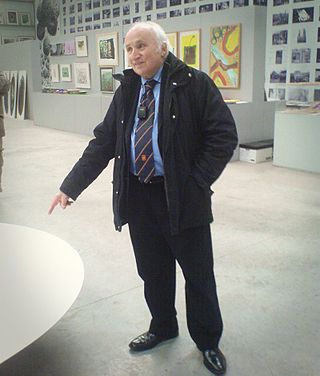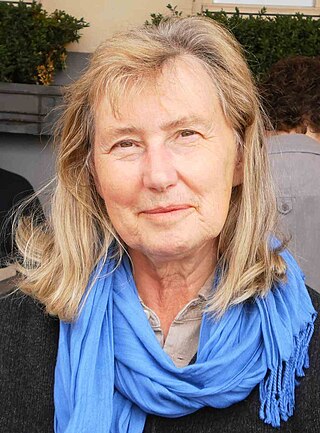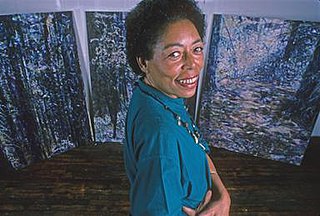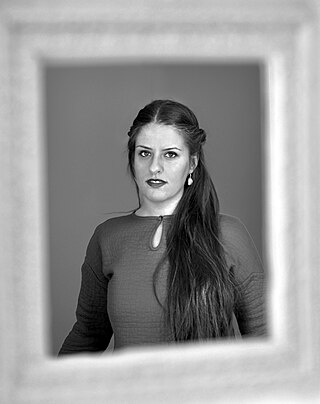Video art is an art form which relies on using video technology as a visual and audio medium. Video art emerged during the late 1960s as new consumer video technology such as video tape recorders became available outside corporate broadcasting. Video art can take many forms: recordings that are broadcast; installations viewed in galleries or museums; works streamed online, distributed as video tapes, or DVDs; and performances which may incorporate one or more television sets, video monitors, and projections, displaying live or recorded images and sounds.

David Hall was an English artist, whose pioneering work contributed much to establishing video as an art form.

Elaine Frances Sturtevant, also known professionally as Sturtevant, was an American artist. She achieved recognition for her carefully inexact repetitions of other artists' works.

Richard Demarco CBE is a Scottish artist and promoter of the visual and performing arts.

Duncan of Jordanstone College of Art & Design (DJCAD) is part of the University of Dundee in Dundee, Scotland. It is ranked as one of the top schools of art and design in the United Kingdom.

Jackie Hatfield was an artist, writer, and academic. According to the influential artist-led no.w.here website: "Jackie Hatfield is an artist and writer who makes expanded and participatory cinematic artworks using digital video, performance, sound and digital print. She has co-edited two critical books around women's use of technology in art practice and has published essays that concentrate on under-explored histories of experimental film and video practices."
Zuzanna Janin, is a Polish visual artist and former teenage actor. Janin lives and works in Warsaw and London. Janin has created sculpture, video, installation, photography and performatives. She used the names Zuzanna Baranowska (1990-1992) and from 1992 Zuzanna Janin. Her work was shown in the Museum of Contemporary Art, Chicago; and A.I.R Gallery New York. She is included in Feminist Artists Data in Brooklyn Museum, NY.

Stephen Partridge is an English video artist who studied under David Hall and his career as an artist, academic and researcher, helped to establish video as an art form in the UK.

Renate Bertlmann is an Austrian feminist avant-garde visual artist, who since the early 1970s has worked on issues surrounding themes of sexuality, love, gender and eroticism within a social context, with her own body often serving as the artistic medium. Her diverse practice spans across painting, drawing, collage, photography, sculpture and performance, and actively confronts the social stereotypes assigned to masculine and feminine behaviours and relationships.

Else Madelon Hooykaas is a Dutch video artist, photographer and film maker. She makes films, sculptures, audio-video installations and has published several books.
Mary Beth Edelson was an American artist and pioneer of the feminist art movement, deemed one of the notable "first-generation feminist artists". Edelson was a printmaker, book artist, collage artist, painter, photographer, performance artist, and author. Her works have been shown at the Museum of Modern Art, the Smithsonian American Art Museum, and the Museum of Contemporary Art in Chicago.
Nil Yalter is a Turkish contemporary feminist artist. She attended Robert College in Istanbul, Turkey and currently lives and works in Paris. Her work, which is included in many collections and museums, includes not only drawings and photographs, but also videos and performance art. In fact she is the first Turkish female video artist.
Catherine Elwes is a British artist, curator and critic working predominantly in the field of video art and a significant figure in the British feminist art movement. She was born in St Maixent, France. She studied at the Slade School of Fine Art and later graduated with an MA in Environmental Media from the Royal College of Art. She began working with video in the late 1970s. In 1979 Elwes performed Menstruation II, a three-day performance at the Slade which lasted for the duration of a menstrual period.

Vivian E. Browne was an American artist. Born in Laurel, Florida, Browne was mostly known for her African-American protest paintings, and linking abstraction to nature. She has received multiple awards for her work, been an activist, professor and a founder of many galleries. According to her mother, Browne died at 64 from bladder cancer.

Tahmineh Monzavi is an Iranian photographer. Her works have been exhibited in museums in several countries, and published by international art magazines and books. She received the Sheed Award in 2011.

Birgit Jürgenssen (1949–2003) was an Austrian photographer, painter, graphic artist, curator and teacher who specialized in feminine body art with self-portraits and photo series, which have revealed a sequence of events related to the daily social life of a woman in its various forms including an atmosphere of shocking fear and common prejudices. She was acclaimed as one of the "outstanding international representatives of the feminist avant-garde". She lived in Vienna. Apart from holding solo exhibitions of her photographic and other art works, she also taught at the University of Applied Arts Vienna and the Academy of Fine Arts Vienna.
Barbara Zeigler (1949) is a Canadian visual artist with a focus in print media. She has also worked in drawing, video, installation and collaborative public art, often combining these media with her work in print to prompt questions as to the character and consequences of our existing cultural paradigms. Her artwork focuses on the evolving relationship between human culture and the ecosphere, with special consideration given to the ways in which individual and collective identity become evident through land usage. Zeigler lives and works in Vancouver, British Columbia, Canada.

Margot Pilz is an Austrian visual artist and a pioneer of conceptual and digital art in Austria. She was one of the first Austrian artists to combine computers and photography. Her works reflect the avant-garde culture of the 1960s and 1970s in their experimental techniques and performative aspects. Her work received renewed attention in the 2010s.
Feminist Avantgarde: Art of the 1970s is an international series of exhibitions and a book publication curated and edited by the Austrian art historian Gabriele Schor about feminist art in the second half of the twentieth century.

Gabriele Schor, born in Vienna in 1961, is an Austrian writer, art critic and curator. She is a specialist of the feminist avantgarde of the 1970s.


















